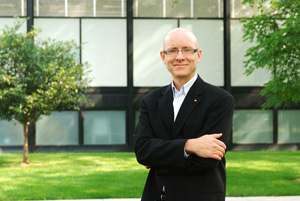
When one considers Chicago’s rich architectural legacy, iconic buildings first come to mind. But there are other notable projects that instead transform pockets of the urban environment into sanctuaries that provide an escape from the gritty into the sublime. Humboldt Park, the Lincoln Park Lily Pool, and the Chicago Botanic Garden are world-class examples of the field of design known as landscape architecture. Recognizing that space and resource utilization within cities have taken on an increased urgency, IIT College of Architecture developed the Program of Landscape Architecture, the only such professional program in Chicago, which graduated its first class of Master of Landscape Architecture (M.L.A.) students in May 2009.
“Essentially, landscape architects are involved in all aspects of land organization, design, and management,” says Peter Osler, director of the program. Project examples range from residential settings to public plazas to vast territories managed by the federal government.
Osler notes that the current 21 full-time and eight part-time master’s students in IIT’s three-year program hold degrees in fields as diverse as business, environmental studies, fine arts, law, and philosophy. This provides a variety of viewpoints crucial to the interdisciplinary nature of landscape architecture.
With today’s emphasis on sustainability and “going green,” students are entering the profession at an especially fertile time. “A lot of the students come into the program with an interest in ecological issues. When they become exposed to design and grasp the role of design in improving the environment, many become very excited about the possibility of the project challenges being solved with an artistic hand and mind,” Osler explains. “It’s not just an ecological system but a complex that needs to be formed, molded, directed, and staged.”
In such projects, a multidisciplinary-team approach is gaining ground, with landscape architects working alongside ecologists, hydrologists, and other scientists to understand various layers of information and to synthesize them in a meaningful way. Developing space for urban agriculture in metropolitan regions like Chicago is another new area of interest for landscape architects, as more emphasis is being placed on local food sources and more innovative, efficient ways to supply communities with fresh produce. An elective course on urban agriculture offered in spring 2009 was so popular that another is being scheduled for 2010.
From late August to December 2009, students in a studio course led by Chicago landscape architect Terry Guen utilized the Midewin National Tallgrass Prairie as their field classroom. Established in 1996, Midewin is the first national tallgrass prairie in the country and is undergoing a rebirth from its former identity as part of the Joliet Army Ammunition Plant. IIT students employed a geographic information system (GIS) as a basis of regional-scale ecological landscape planning and design. A GIS captures, stores, analyzes, manages, and presents data that is linked to a location.
Guen explains that “the ecological, social, and historic components of the site were analyzed based upon GIS files provided to IIT by the U.S. Forest Service and Midewin National Tallgrass Prairie as part of their educational mission. In addition, the students collected data from numerous state and regional agencies, and took multiple trips to the site to correlate their collected information with personal experience.” At the students’ mid-term presentation of their findings to Midewin staff, Guen says, “The ultimate compliment was paid when the planners requested copies of the students’ analyses and suitability studies.”
Following the presentation, students pursued individual projects based upon 14 ecological design principles they developed through their site suitability findings. Rick Short, Midewin’s resident landscape architect, is one of the planners who reviewed the students’ presentation and is helping to guide the prairie’s establishment as part of a long-range plan set in place by the USFS. A landscape architect for the past 23 years, Short believes that the profession is on solid ground.
“The more demands we have on the land, the greater the need for landscape architects,” he says.